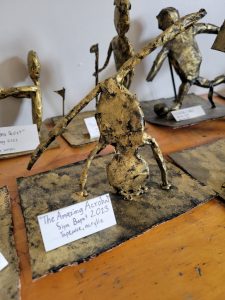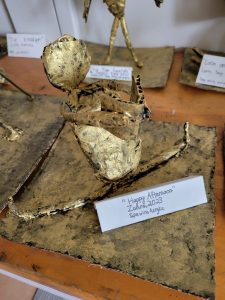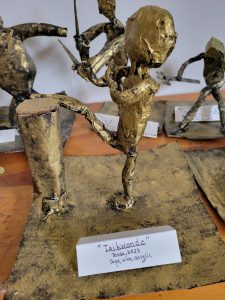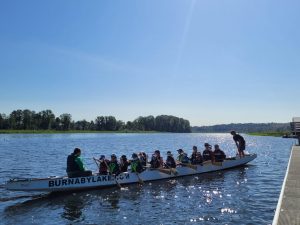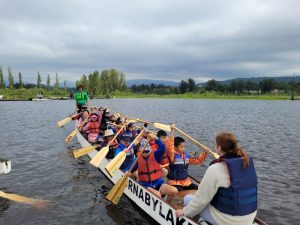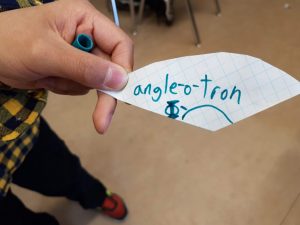Overview Term 3, March – June 2023: Fantastic Work Division 5!
Here is a review of the many things we did during term three!
To tie the big ideas from our curriculum together into a larger, enduring understanding,
we studied subject areas through the lens of universal, conceptual themes.
In March – April, we focused on the concept of POWER
in the unit
COMMUNICATION IS THE KEY!
Our unit focus statement: Being an educated citizen requires reflection and critical thinking about how we communicate and receive information.
What is media and how can we gain personal POWER by being educated about it?
(Socials/Career Education/Language Arts/Critical Thinking/Communication/ADST)
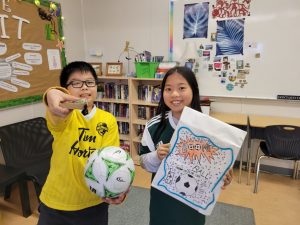 We identified a variety of media forms and looked closely at how their construction, content, advertisements, and reading level were related to their potential audience and purpose. We discussed what it means to be media literate, started taking greater notice of how much time we were spending with media, and discovered how it is present everywhere in our lives. All of this is an important part of being a CRITICAL THINKER and a responsible consumer of media.
We identified a variety of media forms and looked closely at how their construction, content, advertisements, and reading level were related to their potential audience and purpose. We discussed what it means to be media literate, started taking greater notice of how much time we were spending with media, and discovered how it is present everywhere in our lives. All of this is an important part of being a CRITICAL THINKER and a responsible consumer of media.
We compared the outside appearance of cereal packages, looking at how companies market products to children with bright colours, cool characters, games, and other gimmicks. Then we made some sample cereal boxes of our own!
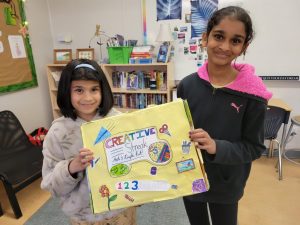 We looked at media advertisements to see what kinds of gimmicks were being used to make us want to buy products. We played games on the Canadian Media Smarts Literacy 101 website together to practice recognizing gimmicks in both print ads and commercials. To show our understandings, we created our own products to sell in a live commercial! We had a wide range of interesting things to sell, complete with catchy brand names, jingles, and slogans to appeal to the consumer.
We looked at media advertisements to see what kinds of gimmicks were being used to make us want to buy products. We played games on the Canadian Media Smarts Literacy 101 website together to practice recognizing gimmicks in both print ads and commercials. To show our understandings, we created our own products to sell in a live commercial! We had a wide range of interesting things to sell, complete with catchy brand names, jingles, and slogans to appeal to the consumer.
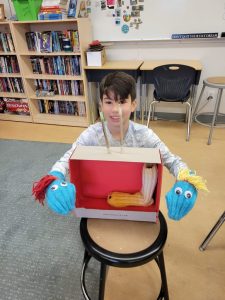 We became more aware of how to search for information online, avoiding commercial websites and looking for reliable sources not full of advertisements or false information. We discussed digital citizenship, learning how online games and social media collect personal information about us while we are having fun online. We played the game Data Defenders to practice NOT giving our information away, keeping our identities safe.
We became more aware of how to search for information online, avoiding commercial websites and looking for reliable sources not full of advertisements or false information. We discussed digital citizenship, learning how online games and social media collect personal information about us while we are having fun online. We played the game Data Defenders to practice NOT giving our information away, keeping our identities safe.
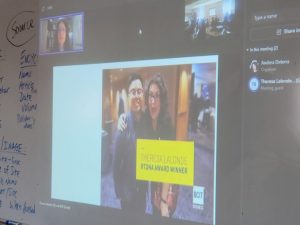 We also learned about what media reports look and sound like. Theresa Lalonde, a production manager for the CBC and teacher of journalism at BCIT, did a virtual visit with us to explain what it is like to work in journalism, and how journalists have POWER through their ability to deliver important information to the public that can help citizens be informed, make good decisions, and be able to advocate for themselves.
We also learned about what media reports look and sound like. Theresa Lalonde, a production manager for the CBC and teacher of journalism at BCIT, did a virtual visit with us to explain what it is like to work in journalism, and how journalists have POWER through their ability to deliver important information to the public that can help citizens be informed, make good decisions, and be able to advocate for themselves.
As part of language arts, we learned how a news article is written, and we watched television news broadcasts to see what tone and format is used to deliver information through visual media.
We participated in an editors meeting, in which each of us chose a Suncrest-related topic to report on for our group newspaper, the Suncrest Sun News, which we presented at Student Led Conferences. There were interesting reports on Primary Days of Music, Littering on the Playground, Wasting Supplies, and Gardening at Suncrest, among many other topics!
How do we communicate scientific ideas and discoveries?
The POWER of careful observation and documentation!
(Science, Language Arts, Critical Thinking, Communication)
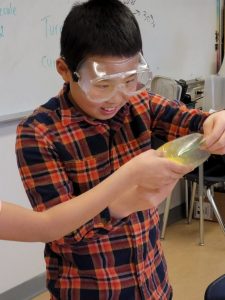 As we have been doing all year, we focused on saying your “becauses” or providing evidence to back up ideas. We talked about the POWER of careful observation and documentation for communicating and developing scientific ideas, especially if you want to prove your discoveries and further your research.
As we have been doing all year, we focused on saying your “becauses” or providing evidence to back up ideas. We talked about the POWER of careful observation and documentation for communicating and developing scientific ideas, especially if you want to prove your discoveries and further your research.
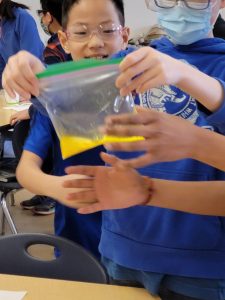 Through an exciting lab in which we changed one substance into another, making limestone, we had the opportunity to discuss physical versus chemical change; acids and bases; natural substances such as turmeric which serve as pH indicators; endothermic and exothermic reactions; and how chemical symbols are used to represent a chemical reaction. Plus we made a bag blow up with gas and it was very exciting!!
Through an exciting lab in which we changed one substance into another, making limestone, we had the opportunity to discuss physical versus chemical change; acids and bases; natural substances such as turmeric which serve as pH indicators; endothermic and exothermic reactions; and how chemical symbols are used to represent a chemical reaction. Plus we made a bag blow up with gas and it was very exciting!!
How do you make a good question to start your research? How do you document observations? How do you write a conclusion with more questions to drive future research?
Everyone also participated in a team debate and learned to use their “becauses” to back up a point of view. We chose topics to debate, and everyone had to write a five-paragraph essay with arguments and FACTS to back up their opinions. Thank you to all of Division 5 for some lively discussions about whether cats or dogs make better pets, whether we should continue financing space exploration, or whether or not video game use has a positive impact on kids!
How are numbers used to communicate ideas in media?
(Math, Critical Thinking, Social Studies)
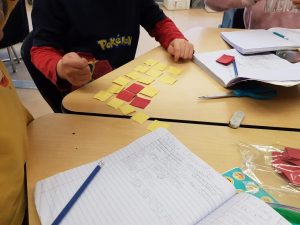 Numbers and data are often thrown into media reports to communicate ideas, and as consumers of media, we need to be critical thinkers about what those numbers mean. It often requires a stronger understanding of what is called proportional reasoning.
Numbers and data are often thrown into media reports to communicate ideas, and as consumers of media, we need to be critical thinkers about what those numbers mean. It often requires a stronger understanding of what is called proportional reasoning.
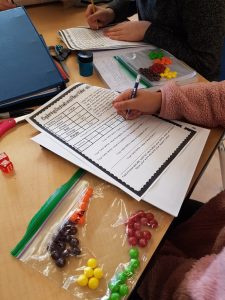 We analyzed news articles on a variety of topics to see how math, particularly graphs, fractions, decimals, and percentages, are used to communicate ideas. If you see numbers, does that mean the information you see is automatically FACT and not someone’s OPINION?
We analyzed news articles on a variety of topics to see how math, particularly graphs, fractions, decimals, and percentages, are used to communicate ideas. If you see numbers, does that mean the information you see is automatically FACT and not someone’s OPINION?
Continuing our work with Carole Fullerton’s Proportional Reasoning, as well as other math resources and games such as SKITTLES MATH, we went deeper into fractions, decimals, and percentages. We were also encouraged to “use the numbers” when making our own news reports, using data to back up our reporting.
Communication, collaboration, and personal awareness give us POWER to make change in our lives or communicate ideas to others: (Communication, PE and Health, Fine Arts)
We continued to have our class meetings, which were important opportunities to express ideas and solve problems. We also continued our work talking about Social Thinking, which is a big part of the core competency on Social Awareness and Responsibility.
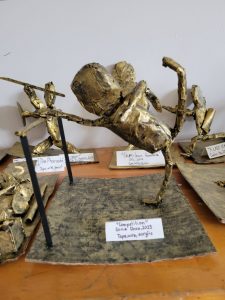 We explored shape and form through sculpture in art. We went over the history of sculpture and how it, too, is a form of media, communicating a message. Each person then created their own sculpture out of steel wire, masking tape, newspaper, and bronze acrylic paint. It was a longer project, but the result was well worth it, as our Museum of Sculptures shows!
We explored shape and form through sculpture in art. We went over the history of sculpture and how it, too, is a form of media, communicating a message. Each person then created their own sculpture out of steel wire, masking tape, newspaper, and bronze acrylic paint. It was a longer project, but the result was well worth it, as our Museum of Sculptures shows!
In April – June, we focused on the concept of CONNECTION
in our unit
THE NATURE CONNECTION.
Unit focus statement:
Human beings impact and rely upon the balance of nature’s interdependent systems.
Unpacking the concept of CONNECTION — What does it mean?
(Science, Socials, Social Responsibility)
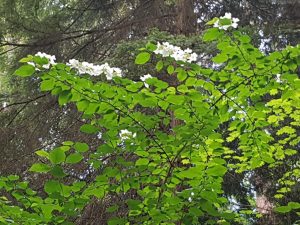 What does connection mean, and where do we see it? We began with class discussions around what we connect to personally, how we are connected to the community, and how we are connected to the world.
What does connection mean, and where do we see it? We began with class discussions around what we connect to personally, how we are connected to the community, and how we are connected to the world.
How are we connected to our natural environment? First we talked about what we can find in our natural environment and had fun deciding what is abiotic and biotic. IS a virus alive or not?? At the end of the day, some of this is still up for debate!
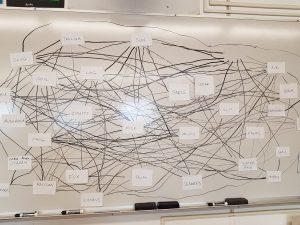 We watched Planet Earth: Pole to Pole, and discussed the variety of biomes, ecosystems, and amazing organisms that exist across the planet. Each student was given a card with an organism within our local ecosystems, and after doing quick research, placed it within the food web and cycles of our world. Further reading was done on how parts of nature are connected through food chains, as well as the carbon, nitrogen, phosphorus, and water cycles.
We watched Planet Earth: Pole to Pole, and discussed the variety of biomes, ecosystems, and amazing organisms that exist across the planet. Each student was given a card with an organism within our local ecosystems, and after doing quick research, placed it within the food web and cycles of our world. Further reading was done on how parts of nature are connected through food chains, as well as the carbon, nitrogen, phosphorus, and water cycles.
Making connections to tell the story of life!
(Science, Critical Thinking)
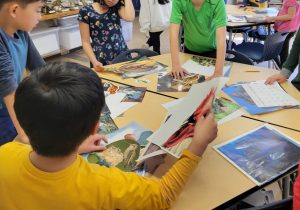 To better understand how organisms in our ecosystems are connected, we investigated taxonomy. Scientists use taxonomy to classify life according to specific features, adaptations, reproductive and survival behaviours, and appearance.
To better understand how organisms in our ecosystems are connected, we investigated taxonomy. Scientists use taxonomy to classify life according to specific features, adaptations, reproductive and survival behaviours, and appearance.
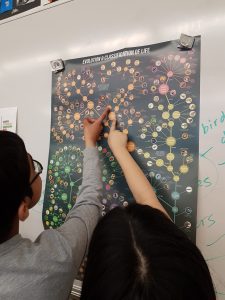 Before we looked at the official chart, we did our own hands-on sorting, and small groups were given piles of pictures of animals and organisms to organize into specific groups according to characteristics. We had lots of great debate!
Before we looked at the official chart, we did our own hands-on sorting, and small groups were given piles of pictures of animals and organisms to organize into specific groups according to characteristics. We had lots of great debate!
Then we had an opportunity to learn about the classification system, picking an animal and learning about their kingdom, phylum, family, class, genus, and official Latin species name, as well as their connection to the First Peoples of BC.
How do we become more connected to and observant of the nature around us?
(Science, Socials, Critical Thinking, Fine Arts, Physical Health Education)
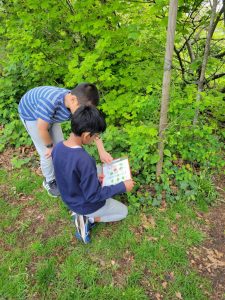 As we looked at how we are connected to other organisms, we developed a better understanding of place and the nature directly around us. Through the Burnaby-New West Walk30 Challenge we walked thousands of minutes with our families! We also won a gift certificate to a local bookstore for participating!
As we looked at how we are connected to other organisms, we developed a better understanding of place and the nature directly around us. Through the Burnaby-New West Walk30 Challenge we walked thousands of minutes with our families! We also won a gift certificate to a local bookstore for participating!
During class activities outside, we used the SFU Walking Curriculum, a series of activities designed to help us become more observant, mindful, and thoughtful about what we are seeing and experiencing
We used loupes and the Private Eye Kits from the District Library to look carefully at natural specimens and plants. We talked about how to observe shape and line quality first when trying to carefully draw specimens, and we did several still-life, up-close drawings to record outside findings.
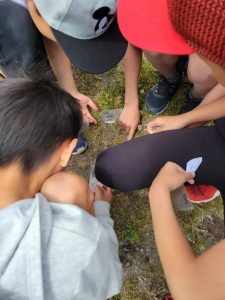 We learned Indigenous names and uses for local plants and trees, identified invasive plants that are not part of the ecosystem, and discussed local animals and habitats. We watched episodes of David Suzuki’s The Nature of Things, and enjoyed learning about creatures in the tidal zone, the important role of scavengers, and the kingdom of fungi.
We learned Indigenous names and uses for local plants and trees, identified invasive plants that are not part of the ecosystem, and discussed local animals and habitats. We watched episodes of David Suzuki’s The Nature of Things, and enjoyed learning about creatures in the tidal zone, the important role of scavengers, and the kingdom of fungi.
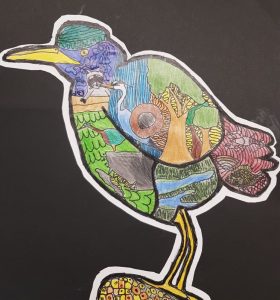 Finally, we talked about extinct, endangered, and protected organisms in B.C. Everyone chose a unique organism from BC they didn’t know anything about, then researched its biome, ecosystem, habitat, taxonomy, adaptations, behaviours, and connection to First Peoples stories and art. We presented our findings through a beautiful piece of art inspired by the works of Oregon artist Sue Coccia.
Finally, we talked about extinct, endangered, and protected organisms in B.C. Everyone chose a unique organism from BC they didn’t know anything about, then researched its biome, ecosystem, habitat, taxonomy, adaptations, behaviours, and connection to First Peoples stories and art. We presented our findings through a beautiful piece of art inspired by the works of Oregon artist Sue Coccia.
Also, for exercise, and to practice the curricular and core competencies around collaboration and communication, we went Dragon Boating at Burnaby Lake! In the process, we learned a new way to connect with the place around us and to make ourselves physically fit. Great job, Division 5, working on teamwork, personal awareness, and SOCIAL THINKING as we rowed across the whole lake!
Becoming Further Aware of Traditional Indigenous Ecological Knowledge:
(Socials, Science, Indigenous Education)
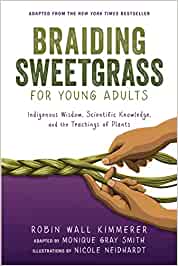 As we developed observation skills that help with scientific investigations, we also asked, “What is science?” We discussed how we would define western science and what is considered traditional ecological knowledge of First Peoples. For example, in western science we classify things into abiotic and biotic; whereas in Indigenous cultures, many abiotic forms are alive, given each form plays a specific role in the ecosystem and was placed there for a reason.
As we developed observation skills that help with scientific investigations, we also asked, “What is science?” We discussed how we would define western science and what is considered traditional ecological knowledge of First Peoples. For example, in western science we classify things into abiotic and biotic; whereas in Indigenous cultures, many abiotic forms are alive, given each form plays a specific role in the ecosystem and was placed there for a reason.
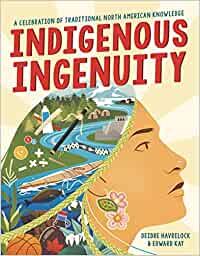 Ms. D read some of Braiding Sweetgrass, as well as Indigenous Ingenuity, to help us discuss how traditional knowledge is being used to help protect the land and to find solutions to some of the challenging environmental problems we have in the world. We watched videos and read about how First Peoples are working in partnership with scientists to manage local waterways, and how Indigenous knowledge provides careful observations from years and years of living on the land. We learned about clam gardens and how First Peoples managed marine food systems, so we can better protect food sources today. Overall, we had great discussions about our connection to the land and the value of traditional knowledge!
Ms. D read some of Braiding Sweetgrass, as well as Indigenous Ingenuity, to help us discuss how traditional knowledge is being used to help protect the land and to find solutions to some of the challenging environmental problems we have in the world. We watched videos and read about how First Peoples are working in partnership with scientists to manage local waterways, and how Indigenous knowledge provides careful observations from years and years of living on the land. We learned about clam gardens and how First Peoples managed marine food systems, so we can better protect food sources today. Overall, we had great discussions about our connection to the land and the value of traditional knowledge!
How are our actions connected to the health of the environment?
(Social Studies, Science, Social Responsibility, Personal Awareness)
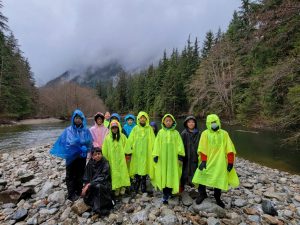 Part of being better connected to nature is better understanding our role in keeping the environment we depend upon healthy! We had a variety of amazing virtual and in-person field trips this unit to help us get out in the community and to discuss social responsibility to our planet.
Part of being better connected to nature is better understanding our role in keeping the environment we depend upon healthy! We had a variety of amazing virtual and in-person field trips this unit to help us get out in the community and to discuss social responsibility to our planet.
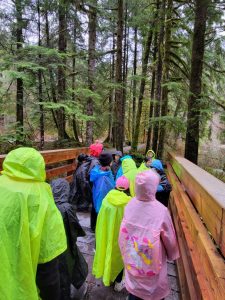 First, we had a trip to the beautiful GVRD Lower Seymour Watershed, learning about the water cycle, where our water comes from, and how the ecosystem of the mountains plays a role in providing us with such clean water.
First, we had a trip to the beautiful GVRD Lower Seymour Watershed, learning about the water cycle, where our water comes from, and how the ecosystem of the mountains plays a role in providing us with such clean water.
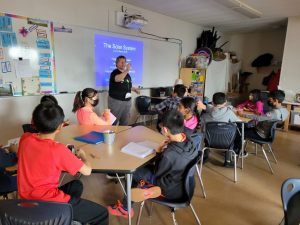 Then, we were fortunate to have a visit from an astronomy instructor at Douglas College, who did a presentation on the planets and our connection to them. We learned a lot about the size of the planets, and why Earth is in the Goldilocks position to support life.
Then, we were fortunate to have a visit from an astronomy instructor at Douglas College, who did a presentation on the planets and our connection to them. We learned a lot about the size of the planets, and why Earth is in the Goldilocks position to support life.
We also had a virtual presentation on Curious Crows from the Vancouver Avian Research Centre , looking at their role in our ecosystem. We found out why they live such long lives in comparison to other birds and corvids, and we found connections between their animal behaviours and our own!
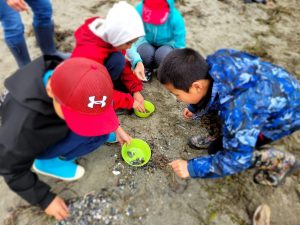 As part of the GVRD’s local parks education programs, we went to Boundary Bay Centennial Beach to learn about organisms in the tidal zones, during a workshop called Seashore Sleuths! It was a great day at the beach, identifying organisms like beach hoppers, ribbon worms, ghost shrimp, and clams, and digging in the mud of the tidal pools!
As part of the GVRD’s local parks education programs, we went to Boundary Bay Centennial Beach to learn about organisms in the tidal zones, during a workshop called Seashore Sleuths! It was a great day at the beach, identifying organisms like beach hoppers, ribbon worms, ghost shrimp, and clams, and digging in the mud of the tidal pools!
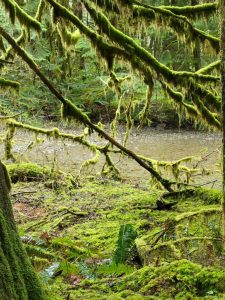 Finally, we talked about global warming and climate change, listening to the inspirational Bill Nye explain the science and the possible problems that will occur. We read articles and watched videos about desertification, pollution, and other human-made disasters in the environment. Everyone had an opportunity to also read about how people are solving these problems, through the Orca Footprints book series on EPIC about topics such as ocean health, landfills, future agriculture, and green transportation.
Finally, we talked about global warming and climate change, listening to the inspirational Bill Nye explain the science and the possible problems that will occur. We read articles and watched videos about desertification, pollution, and other human-made disasters in the environment. Everyone had an opportunity to also read about how people are solving these problems, through the Orca Footprints book series on EPIC about topics such as ocean health, landfills, future agriculture, and green transportation.
Finding Reading Connections & Using Literary Devices
(Language Arts, Fine Arts, Critical Thinking and Questioning)
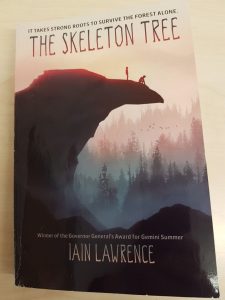 Ms. D read The Skeleton Tree, while everyone followed along and took notes as they collected thoughts about new vocabulary, key details, connections, or questions while reading. This involved metacognition — becoming aware of how we think so we can improve our critical thinking! The book tells the story of two boys stranded on the Alaska coast and how they survive.
Ms. D read The Skeleton Tree, while everyone followed along and took notes as they collected thoughts about new vocabulary, key details, connections, or questions while reading. This involved metacognition — becoming aware of how we think so we can improve our critical thinking! The book tells the story of two boys stranded on the Alaska coast and how they survive.
We created comprehension questions of greater depth using Question and Response (QAR), and students explained this in their e-port entries about the book. It was an exciting tale that connected well to our unit!
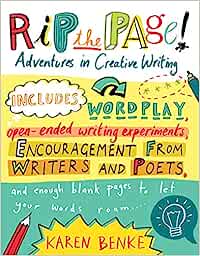 We also explored how to use figurative language, literary devices, and different poetry formats to express our feelings about things we are CONNECTED to personally. Using Adrienne Gear’s Poetry Power we talked about why people use poetry versus other forms of writing for expressing ideas and emotions. We did writing exercises from the book Rip the Page to further develop our descriptive vocabulary, and to help us with written output and creative thinking. We learned about alliteration, onomatopoeia, personification, metaphor, and similes, as well as poetic forms such as tankas, list poems, free verse, and cinquains.
We also explored how to use figurative language, literary devices, and different poetry formats to express our feelings about things we are CONNECTED to personally. Using Adrienne Gear’s Poetry Power we talked about why people use poetry versus other forms of writing for expressing ideas and emotions. We did writing exercises from the book Rip the Page to further develop our descriptive vocabulary, and to help us with written output and creative thinking. We learned about alliteration, onomatopoeia, personification, metaphor, and similes, as well as poetic forms such as tankas, list poems, free verse, and cinquains.
Everyone displayed their poems in a creative poetry journal or zine to share with others!
Connection Between Nature and Math!
(Math, Art, Science, Applied Design)
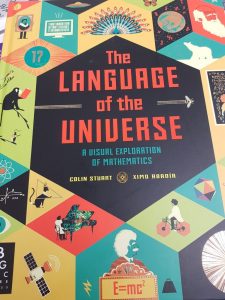 Our main focus was geometry and math related to patterns in nature. First, we made ourselves familiar with some geometry terms and tools. We looked at polygons and platonic solids on Mathigon, and we practiced identifying, measuring, and trisecting angles through some fun origami. Then, Ms. D read sections of books about nature and math, such as The Language of the Universe.
Our main focus was geometry and math related to patterns in nature. First, we made ourselves familiar with some geometry terms and tools. We looked at polygons and platonic solids on Mathigon, and we practiced identifying, measuring, and trisecting angles through some fun origami. Then, Ms. D read sections of books about nature and math, such as The Language of the Universe.
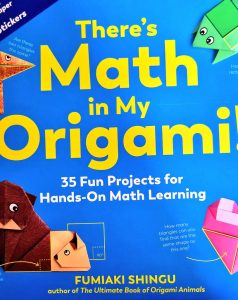 During our ventures outside, we looked for examples of these patterns in the nature around us. We discussed Fibonacci, the Golden Mean, spirals, and fractals found in plants, wave patterns, our bodies, and genetics.
During our ventures outside, we looked for examples of these patterns in the nature around us. We discussed Fibonacci, the Golden Mean, spirals, and fractals found in plants, wave patterns, our bodies, and genetics.
We had a great time discovering pentominoes, which are shapes formed by combining five 2D cubes together. We worked together to see how many different combinations of cubes we could make that would form unique pentominoes, and there are 12! We had to use the math concepts of rotation, translation, and reflection to ensure we did not have congruent shapes and had indeed created something new. We played several fun games to work with visual-spatial patterns!
Students also completed activities about measurement, area, perimeter, shape classification, volume, angles, multiplication, division, fractions, and decimals through applied math problems about nature in the books Animal Math and Planet Earth Math, as well as Geometry and Measurement for Intermediate Grades.
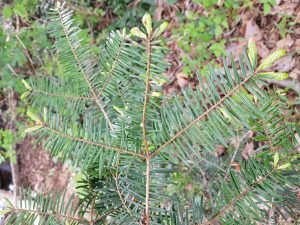 We also watched a video series called Doodling in Math Class about nature math, and made our own, portable “angle-a-trons” for 137.5 degrees to try outside on plants, confirming leaves grow in specific, consistent angle patterns to maximize light exposure.
We also watched a video series called Doodling in Math Class about nature math, and made our own, portable “angle-a-trons” for 137.5 degrees to try outside on plants, confirming leaves grow in specific, consistent angle patterns to maximize light exposure.
We found a lot of symmetry in nature, and we created careful drawings of butterflies, using pastel and watercolor to make balanced compositions.
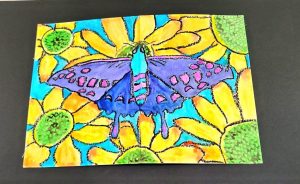 Finally, we used our discussion of geometry and measurement to create scale models of objects so we would understand how to make a scale model for applied design.
Finally, we used our discussion of geometry and measurement to create scale models of objects so we would understand how to make a scale model for applied design.
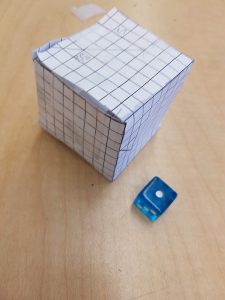 We imagined what the empty grass space in the upper intermediate playground could be like. Using nature math, knowledge of indigenous plants, and our outside observations during the unit, we made scale models of a proposed nature space for relaxing, learning, and taking a break outdoors. Students were asked to incorporate mathematics and unique natural elements into the design. Thank you everyone for your creative results!
We imagined what the empty grass space in the upper intermediate playground could be like. Using nature math, knowledge of indigenous plants, and our outside observations during the unit, we made scale models of a proposed nature space for relaxing, learning, and taking a break outdoors. Students were asked to incorporate mathematics and unique natural elements into the design. Thank you everyone for your creative results!
French Basics, Creating Conversation, and Weather!
(Core French, Drama, Language Arts, Creative Thinking)
We worked from the book Learn French the Fast and Fun Way, as we learned some of the basics, such as pronunciation, definite and indefinite articles, how to make plurals, family words, and basic greetings.
We later integrated conversations about the outdoors into our French learning, as well, by focusing on communicating the weather. Some students who had extra time before end of year even created a crazy dialogue to represent the weather in front of the class.
Independent Project!
(Socials, Science, Critical Thinking, Career Education, and Personal Awareness)
 By February, most students had selected topics for independent study. They were allowed to select any topic as long as it was something they sincerely cared about!
By February, most students had selected topics for independent study. They were allowed to select any topic as long as it was something they sincerely cared about!
During each project this year, we worked on the specific curricular competencies and skills to help with a successful independent inquiry.
These skills can be found in almost every aspect of the curriculum, including career education, social studies, language arts, science, fine arts, and applied design. Here is a quick summary:
- Understanding passions and making a commitment to pursue a personal interest
- Project management, goal setting, and meeting deadlines
- Self-management as they monitor their time during open work periods
- Asking questions that further an inquiry, including open and closed questions
- Documenting and organizing research through notes and a bibliography
- Searching online effectively, including finding reliable and safe resources
- Using critical thinking to analyze resources and summarize findings
- Communicating findings in writing and through public speaking
- Applying creative thinking by sharing results through a variety of media
We had a wide variety of topics including things like human bonds with pets, C sharp programming, earthquakes versus skyscrapers, rapid transit, the science of refrigeration, Ancient Egypt, animal venom, fishing, and more!
Digital versions of our Independent Projects can be found here.
We hope this provides you a snapshot of all the great learning Division 5 did in term three! Please see individual e-portfolios for more information and photos of your child’s projects and thinking about the units!

